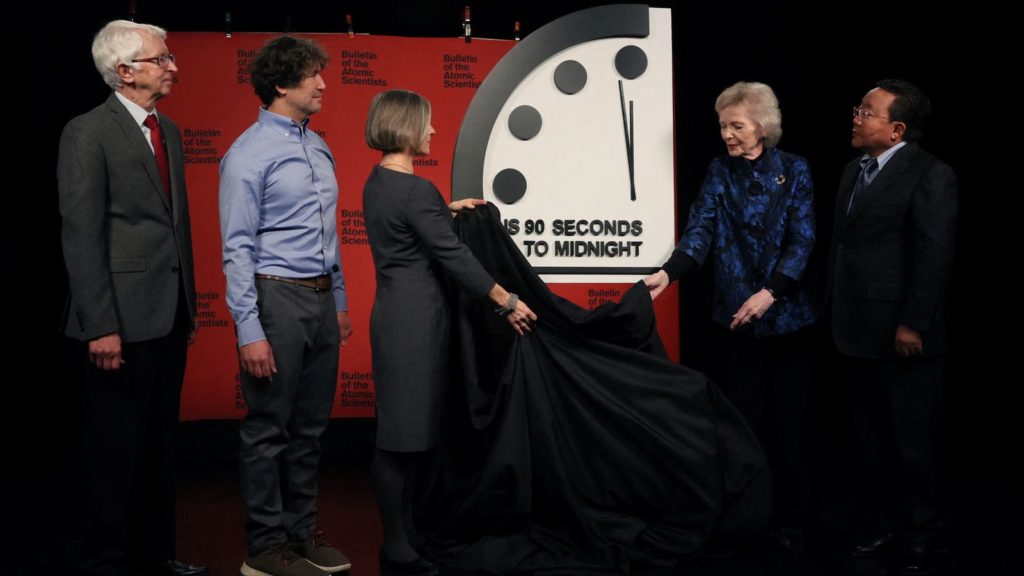Doomsday Clock: What is it and how does it work? | World News

The Doomsday Clock has been reviewed after inching 10 seconds closer to midnight in 2023 – the closest it has ever been to a global catastrophe.
The clock’s new time was announced on Tuesday 23 January and remains at 90 seconds to midnight.
But what does it actually mean?
A metaphor for the dangers facing humanity, the clock is updated based on perceptions about how close humans are to destroying the world – with midnight symbolising that point.
The countdown is agreed on by experts at the Bulletin of the Atomic Scientists.
Last year the clock moved forward due to the “mounting dangers of the war in Ukraine“. It was the first time the time had changed since 2020.
Experts said the increase in nuclear threat, political tensions, climate change and illnesses made 2023 a “time of unprecedented danger”.
What is the Doomsday Clock and how is it set?
The Bulletin of the Atomic Scientists – the creators of the clock – first launched the initiative in response to the threat of nuclear war in the 1940s.
After the US dropped atomic bombs on Hiroshima and Nagasaki at the end of the Second World War, members of the Bulletin saw a need to help the public understand the scale of the nuclear threat to the existence of humanity.
To this day, the Bulletin’s science and security board, made up of nuclear and climate experts, set the time for the clock. The board has done this since 1973, when it took over from Eugene Rabinowitch, Bulletin editor and disarmament campaigner.
The clock moves closer to or further away from midnight based on how the experts on the board, plus academic colleagues and the Bulletin’s sponsors – which include 13 Nobel laureates – read the threats facing the world.
Read more:
Doomsday Clock moves closer to midnight as Ukraine war rages
Where you should head to survive an apocalypse
What have scientists said?
The 2023 update to the clock was the most dire since its conception.
Announcing the update, the board said: “Russia’s thinly veiled threats to use nuclear weapons remind the world that escalation of the conflict by accident, intention, or miscalculation is a terrible risk.
“The possibility that the conflict could spin out of anyone’s control remains high.”
The scientists said the war has “increased the risk of nuclear weapons use, raised the spectre of biological and chemical weapons use, hamstrung the world’s response to climate change, and hampered international efforts to deal with other global concerns”.
The Russia-Ukraine war has moved the Doomsday Clock closer to midnight
The Bulletin’s warning continued: “The invasion and annexation of Ukrainian territory have also violated international norms in ways that may embolden others to take actions that challenge previous understandings and threaten stability.
“In this time of unprecedented global danger, concerted action is required, and every second counts.”
The Doomsday Clock’s history
When it first began in 1947, the clock was set at seven minutes to midnight.
Artist Martyl Langsdorf came up with the idea of the clock and set the time to symbolise the dangers of nuclear confrontation, on the front cover of the Bulletin.
Since then it has been ticking away as political, nuclear and climate changes continued over the years, with experts revising the time up and down – mostly closer to midnight and its metaphor for total disaster.
There have been more reassuring years, though. In 1995 the clock was at 14 minutes to midnight, the safest reading in its history.
And there were “positive strides” in some years, such as the Paris climate agreement.
Ever since 1998, however, the hands of the clock have been at less than 10 minutes to midnight.
In 2020, scientists moved the hands of the clock forward to 100 seconds to midnight after the breakout of COVID-19.
Recent Posts
- World of Hyatt and Headspace Launch New Series to Help Travelers Find A Good Night’s Sleep
- Influencers signed up as Abta kicks off pre-peaks promotion
- Peter Island Resort Set for December Debut in the British Virgin Islands
- PM Hotel Group Expands Washington, DC Area Portfolio With Management of Three Hotels
- A snowshoe hike in Bormio, the host of the 2026 Winter Olympics





Recent Comments